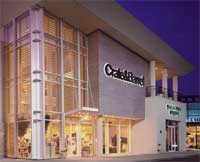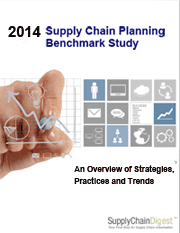 |
December 12, 2013 - Supply Chain Flagship Newsletter |
 |
| THIS WEEK'S SPONSOR: QUINTIQ |
 |
Is 2013's most wanted tablet on your Christmas list? |
 |
|
|||||||||||||||||||||||||||||||||||||||||||||||||||||||||||||||||||||||||||||||||||||
No Supply Chain Blah, Blah, Blah 2013
|
||||||||||||||||||||||||||||||||||||||||||||||||||||||||||||||||||||||||||||||||||||||
| GILMORE SAYS: |
"I welcome your nominees for any outstanding presentations you had a chance to see in 2013." WHAT DO YOU SAY? |
My conference schedule was relatively light this year. I just didn't get to a few events I sometimes do, such as NASSTRAC. I can't find that I made it to any local CSCMP roundtables, though will note I will probably attend or speak at a couple of them in 2014. JDA acquired RedPrairie, knocking the latter's user conference off the schedule, and several software vendors have gone to 18-month conference cycles, leaving them without a user event in a given calendar year every so often.
That said, in rough chronological order, I attended the National Retail Federation's Big Show, ProMat, the Motorola Solutions channel partner event, the Warehouse Education and Resources Council (WERC) annual conference, the Institute for Supply Management conference, the JDA Software user conference, the Gartner Supply Chain Executive forum, the Material Handling and Logistics conference, and of course the annual CSCMP conference.
I delivered one of our popular trip reports on each of those events in one form or another, including many video summaries.
If I was at your event and have somehow not been able to track it down, please let me know.
So now as always, in random order, is my list of the best presentations I saw in 2013, capped by SCDigest's runner-up and best presentation of the year awards. To the best of my knowledge, all those cited are still with their companies at the time of the presentations, but of course that could have changed for some of them.
Annette Danete-Akey and Alison Martin of book publisher Random House at the WERC conference, on use of the Theory of Constraints in its distribution centers to solve several operational problems. Chief among them were pick slot replenishment challenges. Greatly summarizing, one key component of the final solution was something Random House calls "dynamic buffer management" for its split case picking locations - not sure anyone else is doing this. Thought provoking stuff.
Also at WERC, Dan Basmajian of Optricity, who had to fill in at the last minute for a presentation on slotting in the DC after the scheduled presenter bailed. He was very good. Beyond the insightful ideas on slotting success factors, I liked the approach Basmajian took of organizing the presentation with a sports analogy, meaning you start a goal for the season, develop a winning game plan, create a line-up, conduct spring training, develop a playbook, etc. I think this is an approach that can be very effective for presenting concepts or proposals in many business settings - tuck that idea away for future consideration.
At ISM, just retired GE procurement executive Patrick MacMonagle gave an excellent presentation on GE's journey in "spend analytics," and made a compelling case for the technology. How can a company really optimize procurement and maximize supplier leverage if it can't easily quantify what it spends globally across business units, vendors and product types? A point not often considered: making this data easily available speeds the negotiating process and allows procurement managers to do more "deals' each year to drive down costs.
At JDA, Texas Instruments' Gushaman Baweja gave a very interesting presentation on how TI has rigorously standardized its supply chain processes and metrics across its 6 or 7 main business units, largely in reaction to the big disruptions the company, like others, saw first with a large (but it turned out short-lived) drop in demand in late 2008, and then supply disruptions in Japan and Thailand a few years later. Key to the effort was the development of supply chain "playbooks," prescriptive "how to" documents on what a manager or executive needs to do when a given supply chain situation or scenario is encountered. At each step in a playbook, it details what information is needed and where within TI the info can be found. Very cool - don't know how TI found the bandwidth to get these done.
John Phillips, SVP of Customer Supply Chain and Logistics for PepsiCo, gave a great presentation at the Gartner conference on what was nominally the topic of social media (and hence I wasn't expecting much) - but I was wrong. Phillips did an excellent job of detailing a number of developments on the "digital" side of business and why connecting that digital world to the physical supply chain world is going to be increasingly important, as he pointing out many developments on the digital side I simply was not aware of. Book Phillips at your event.
Next are Dalen Mathys-Cook of Peapod and Paul Huppertz of The Progress Group at the Material Handling & Logistics conference, on the on-line grocer's efforts to build a new highly automated - or at least that was the idea - distribution center for the Northeast market that provided excellent insight on the challenges of designing a new and complex DC successfully. The core message - "there's always something," so you need back-up plans in each area. And expect the funding to keep changing as the design moves along.
GE Lighting's David Slates at CSCMP on the company's on-going transition to much greater use of intermodal from truckload shipping. This was just one of those "real deal" presentations. Not one bit of blah, blah, blah and which provided solid insight and education to a packed audience.
That leads us to this year's runner-up for best presentation of the year, which goes to Tony Nikolai of Whirlpool, also at CSCMP, with an excellent presentation on getting the politics out of S&OP. First, this was a solo presentation - no technology vendor or consultant getting in the way of the story, so it got some extra points just from that. It also included substantial detail on how Whirlpool has dramatically improved its S&OP process, and made clear the importance of corporate "will," if that makes sense, in getting to the top levels of S&OP success.
That leaves our clear 2013 winner, Richard Murphy, CEO of Murphy's Warehouse Co., at the WERC conference, on the business case for Green investment in distribution. I was expecting the usual Green talking points - and I was completely wrong. Murphy offered great financial detail relative to the options his company considered and ultimately took, and addressed head on such issues as: Which is better, the option with higher payback but which requires a lot more upfront investment, or the opposite? Great, great insight for the distribution community, using real, unvarnished numbers.
Just FYI, previous SCDigest Best Presentation of the Year award winners were:
2012: Raj Subramonian of Dell, with an outstanding, heartfelt presentation on use of "vested outsourcing" to transform a stale 3PL relationship.
2011: Rudi van Schoor of SABMiller's South African operations at the SAPICS conference there on stopping a major supply chain planning project in mid-stream and totally and successfully re-orienting the approach.
2010: Chris Gaffney of Coca-Cola, how to bring balance into increasingly challenging supply chain careers, and how with the right formula less can really be more for both managers and the company.
2009: Jim Kellso of Intel, on rethinking Intel's supply chain to work for a new chip whose much lower price point required a dramatically lower cost supply chain.
2008: Matt Salmonson of Old Navy/The Gap stores group, who spoke at the i2 user conference, on how to implement software the right way, and make change management happen.
2007: Michael Schofer of Coats North America, describing his company's supply chain transformation, at the i2 user conference.
2006: Paul Mathews of The Limited Brands for his speech on aligning supply chain and the corporate boardroom at the North American Material Handling Show. This was motivational.
2005: Glenn Wegryn of Procter & Gamble, who presented at CSCMP 2005 on how P&G has developed a methodology and set of tools to drive supply chain strategy and planning into overall business strategy and planning - wonderful.
So, that's our list. Congratulations to the winners. There was a lot I missed, of course. I welcome your nominees for any outstanding presentations you had a chance to see in 2013.
Did you see any outstanding presentations, especially any that were highly visionary or motivational? In general, are you happy with the quality of presentations you see at conferences? Let us know your thoughts at the Feedback button (email) or section below.
| View Web/Printable Version of this Page |
|
|
|
YOUR FEEDBACK
We publish a few more of the nice letters we received on our Supply Chain History Project column.
That includes our Feedback of the Week from David MacLeod Learn Logistics Limited, who adds a nice personal anecdote.
Feedback of the Week, on the Supply Chain History Project
I think your History project is a great idea and if there's anything I can assist with from my side of the Atlantic please let me know. I have moved house in the last couple of years and in preparation for the move and since have thrown a huge amount of material out but I hope that I still have some of the more important aspects from my career working in many diverse companies and supply chains from the end of the 1960s through to recent years where I have been an educator and trainer. It was fascinating listening to the 50 year history of CSCMP in Denver. I joined in the early 80s and attended my first conference in St. Louis in 1985. It was there that I heard Prof. LaLonde speak for the first time and I am still using one of his quotes! I also met Roger Kallock for the first time and it was good to see and hear him on the video. I now also realise that others who I worked with were immensely influential in the sector. Eric Baum in the field of engineered labor standards was just one. History gives perspective - it also shows us the complexity of real life that a great deal has to come together for new work and innovation to be successful and sustainable. Just one case study for the archives: I was brought up in London in the 50s and 60s. My mother used to do her shopping for groceries at a local store and most days of the week would walk out and buy food for the evening meal. However on a Thursday morning she would phone the local grocer and give them the big order using as a reminder the front of the previous week's bill showing what she had purchased, and on the reverse a printed list of the main commodities the store stocked. The goods were delivered by van the next morning. No doubt middle class mums did much the same in the USA - 60 years on and the basics haven't changed and we are still discussing how to deliver economically to the home! Keep up your good work.
|
||
Great effort to capture Supply Chain history Dan. I would like to recognize Jay Forrester's pioneering work on Industrial Dynamics as a clear marker in SC history. His work spanning many years under the name Industrial Dynamics was precursor to many of the current advanced SC management ideas. His vision was way bigger than an inspiration for the Beer Game and the bullwhip effect. Quoting from his 1968 article: "The manager's task is to interrelate the separate functions of the company, to create the flows that cause the company and market mutually to support one another, and to interweave the tangible economic variables... The manager's principal problems seemed not to lie in decisions taken as isolated events, but rather in policies that deal with streams of decisions and in the structure of the managerial system that interrelates information sources, policy, and action." Industrial Dynamics-After the First Decade, Jay W. Forrester, Management Science, Vol. 14, No. 7, Theory Series (March 1968), pp. 398-415. Omer Bakkalbasi Chief Innovation Officer, Solvoyo Co.
|
||
SUPPLY CHAIN TRIVIA ANSWER
Q: What is the US share of global manufacturing exports?
A: It was about 12% in 2012, down from 19% in 2000, though it may have risen a bit in 2013. China has of course taken most of that share.
| © SupplyChainDigest™ 2003-2013. All Rights Reserved. SupplyChainDigest PO Box 714 Springboro, Ohio 45066 |
POWERED BY: XDIMENSION
|








